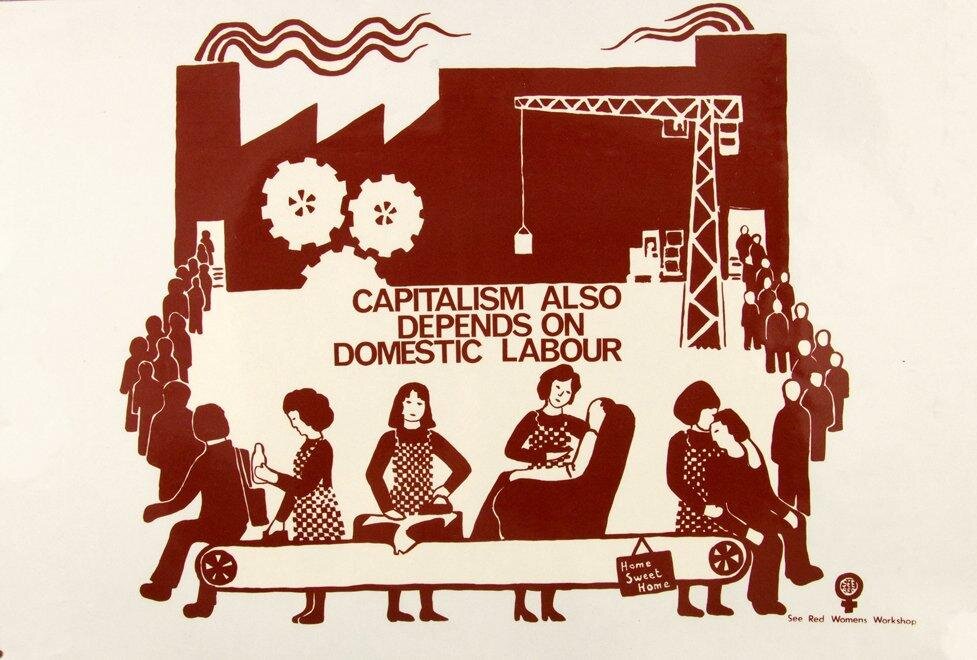See Red Women’s Workshop were a feminist collective who made posters from 1974 to 1990. ID: A screen print poster in red and cream shows women working on a factory production line, doing domestic tasks and care work for people on a conveyor belt. The text reads "Capitalism Also Depends on Domestic Labour".
To Draw a Firm Line - Sara Greavu
Definitions can be slippery. Sometimes in art – because we are producing something that’s new, or at the edge of understanding, or we’re making something through a process of doing rather than simply executing a plan – definitions become even slipperier.
I’ve been thinking about ‘propaganda’; how calling something ‘propaganda’ – a book, a painting, a poster, a mural – is to question its legitimacy; to insult it, to place it in the category of ‘not art’. But I’m not so sure.
We talk about ‘research-driven art’, or ‘socially engaged practice’, but labels like this can be hard to pin down as well. These terms have some accepted definitions that get us part way there. In research-driven art, for instance, the artist often uses methods and processes typical of academic research, drawing from academic disciplines including science, sociology, ethnography, etc. The implication seems to be that artists who do a series of drawings and gather ideas before they make a painting, for instance, aren’t conducting research, but I’m not sure about that either.
Propaganda, at its core, is just an image or other work that promotes a political cause or point of view. Propaganda comes from the same root as ‘propagate’...to spread an idea and help it to grow. Until the 20th century, propaganda was a neutral term; then it became associated with lies, manipulation and authoritarian control.
I have a long-established love of political posters from various movements and historical moments. I am interested in the people and groups that produced them, how they organised themselves, their artistic and political methodologies. These posters often had a direct and urgent purpose at the time of their making – to address an immediate political issue or build a campaign – but the passage of time has changed them. Like many historical objects and artworks, they can open a window to the set of social and artistic circumstances that they emerged from as well as offering us an opportunity to see our current moment anew, allowing us to toggle between timeframes and find the places where they blur together.



See Red Women’s Workshop were a feminist collective who made posters from 1974 to 1990.
Poster 1 See Red Women’s Workshop were a feminist collective who made posters from 1974 to 1990. ID: A screen print poster in yellow, blue orange and green shows young women in various work and leisure activities: jumping and kicking, fixing machines, taking photos, playing ping-pong, etc. The text reads GIRLS ARE POWERFUL.
Poster by Sarah Wilson of Poster Workshop (1968-1971) and residents of the Falls Road, made in 1969.
Poster 2 by Sarah Wilson of Poster Workshop (1968-1971) and residents of the Falls Road, made in 1969. A screen print poster, black on green with an image of a burning row of houses with billowing smoke. The text reads THE FALLS BURNS, MALONE ROAD FIDDLES.
Red on white screen print poster by L’Atelier Populaire.
Poster 3 Red on white screen print poster by L’Atelier Populaire. The image shows a woman throwing a brick with what is perhaps barbed wire behind her. The text reads LA BEAUTÉ EST DANS LA RUE (beauty is in the streets)
In the strange early days of the Coronavirus pandemic, I kept an eye on the website of Justseeds Artists’ Cooperative. Justseeds is “a decentralised network of 41 artists committed to social, environmental, and political engagement”, most of them based in the United States. They have a platform for individual artists to sell their politically-engaged artworks and also a platform for artist-created graphic images that activists anywhere can download for their campaigns. These simple graphic images were just the type of work I wanted to see in those unsettled times, in the same way that I was hungry for the solid, scalable political ideas that made sense of the global crisis. During the first weeks of the lockdown, the artist-activists of Justseeds made several sets of high-resolution topical posters and graphics available for download. You could take these images, dealing with mutual aid or supporting essential workers or Black Lives Matter, and make use of them in your own context...to propagate ideas about community support, healthcare, equity and human dignity.



Josh MacPhee, Justseeds Rent Strike! is licensed under a Creative Commons Attribution-ShareAlike 4.0 International License.
Poster 4 Josh MacPhee, Justseeds Rent Strike! is licensed under a Creative Commons Attribution-ShareAlike 4.0 International License A poster reading RENT FREEZE OR STRIKE! The letters of RENT resemble apartment buildings at night with lit-up windows, FREEZE OR are in aqua on dynamic black lightning bolt shapes and STRIKE! is in red
N.O. Bonzo, Justseeds All We Have Is Each Other, Mutual Aid.
Poster 5 N.O. Bonzo, Justseeds All We Have Is Each Other, Mutual Aid. A green and black woodcut print with bees and flowers arrayed around a traditional skep beehive.
Kevin Caplicki, Justseeds. Sembramos las semillas de la Revolución (We sow the seeds of the Revolution).
Poster 6 Kevin Caplicki, Justseeds. Sembramos las semillas de la Revolución (We sow the seeds of the Revolution). A poster in red and black showing a hand planting seeds.
I prefer an approach to art that thinks that ideas, narrative, context and social relationships are important and relevant over an approach that exclusively privileges form, composition and the visual qualities of a work. I’m interested in art that reflects on – or speaks to, or at least doesn’t ignore – the urgent issues that are pressing down on people now in various ways. My preference, I suppose, is for work that does that obliquely or finds a surprising new frame for me to see through, or transforms my understanding of a thing or set or relationships. But the bottom line is that I’m interested in art that asks questions about how things are and how they might be otherwise. Sometimes, it's difficult – and perhaps, in the end, it's not that useful – to draw a firm line between art and propaganda.
Bio: Sara Greavu is a non-aligned curator and works part time as Queer Arts Development Leader in Outburst Arts, Belfast.


